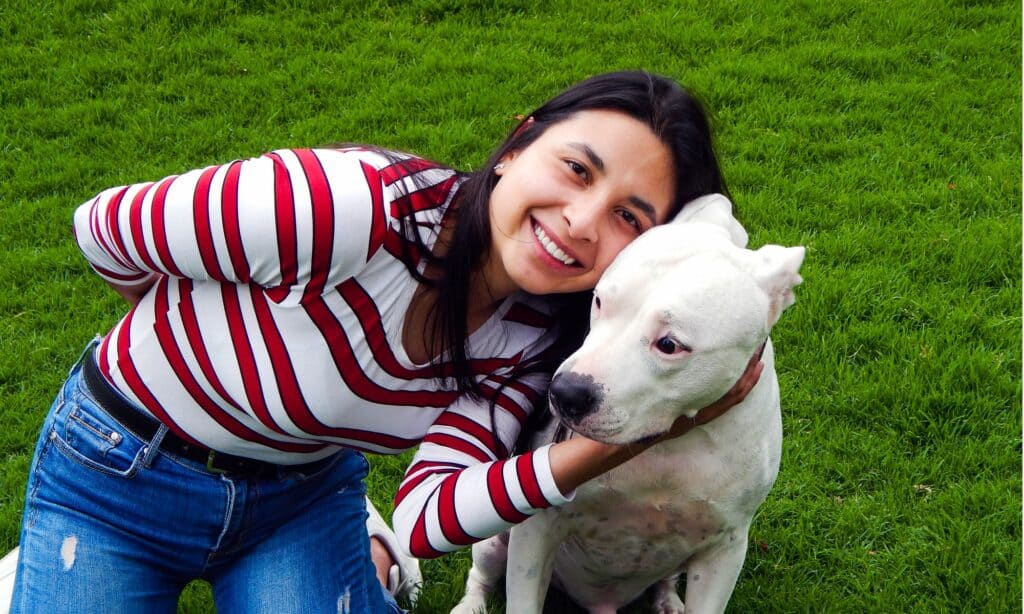You’re lounging in the park with your dog, saying he’s a “good boy” & giving out your normal commands. Suddenly, someone sees your wonderful pup and starts giving them a belly rub, except that they’re saying “bueno perro!”
Your dog seems to love the attention and understand the stranger’s sentiment, so you wonder, “is my dog bilingual?”
Then you wonder, “does my dog even understand English?” It’s kind of a rabbit hole to start thinking about because there’s always an element of mystery when it comes to fully appreciating just how intelligent dogs are.
The short answer is that we’re not totally aware of their full intelligence. How can some dogs sense emotional trauma without any training, find their way home from seemingly impossible distances, or complete extremely complex tasks? These are things that sort of stretch beyond the firm scientific knowledge of dog behavior.
What about language, though? Do dogs simply understand commands, or can they pick up on some of the English language’s nuances without proper training? Let’s take a look.
Human & Canine Language Acquisition

4 PM production/Shutterstock.com
Let’s clear up the question a little. If we’re asking literally whether dogs can understand the English language or not, the answer is ‘‘no.’’
The answer would be ‘‘no’’ for most humans as well, considering that an individual has to take a long time to learn any particular language. If your name was Mark and you only spoke Spanish, the question ‘‘can Mark understand English?’’ would result in a big fat ‘‘no.’’
So, the real question is can dogs understand their humans’ languages? Does your dog understand what you’re saying beyond your normal commands for it?
Further, if your dog were put in front of someone who spoke a different language, would it have less of an idea about what the person was saying?
Baby humans pick up on language simply by being around it. Over the course of a year or two, babies get familiarized with their native sounds and start producing them on their own.
If a puppy is raised in a human family, it’s exposed to the same amount of language that a human baby is, but does that have a similar effect on the canine brain?
Researchers at The Royal Society state that “while dogs have remarkable abilities for social cognition and communication, the number of words they learn to recognize typically remains very low.” Their research opened up some exciting ideas about how to understand our speech, however.
Distinguishing Speech Sounds

Mila Supinskaya Glashchenko/Shutterstock.com
The study linked above shows that dogs are able to decipher between the commands they know and words that probably don’t pertain to them.
For example, say you were to make up a nonsense word that doesn’t sound like any of the commands that your dog knows. If you were to say the nonsense word to your dog, it would know almost immediately that you weren’t giving a command.
Dogs can distinguish between relevant and irrelevant words as they pertain to commands and other significant languages that come from their humans.
That said, when words sound very similar to established commands, dogs have a difficult time making the distinction. For example, if you were to yell “clear,” your dog could easily mistake it for the word “here.”
The study also mentions that most dogs can only understand a handful of words. Fortunately, the wild world of dogs is a little more difficult to pin down than the study above might suggest.
Alternative Theories and Research
While dogs might not be able to distinguish particular words that they aren’t taught, studies show that they can still distinguish between familiar and unfamiliar languages in general.
So, a dog raised in an English-speaking environment would know something was unusual about a person speaking Spanish, for example.
A Hungarian study utilized 18 dogs and scanned their brains while listening to a story in numerous languages. All dogs were trained to lie still in the MRI machine, and brain scans were run as The Little Prince was read to them in various languages.
The research showed that dogs’ brains activated differently when they heard unfamiliar languages compared to when they were hearing the language they were raised with.
It’s important to note that many of the words in The Little Prince wouldn’t have been used in commands. If the dogs weren’t taught the words in the story, but they still recognized the familiarity of them, this suggests that dogs can pick up on the speech patterns and general sounds that come from their native languages.
This study was the first to show that a non-human could distinguish between different human languages. This unique position with humanity could be a result of our long history with dogs, one that has led to mirroring genes and co-evolution.
Co-Evolution Between Dogs and Humans

iStock.com/Arturo Rosenow
Communication is an essential component of the human-canine connection, but so is diet. Let’s look at the co-evolution of dogs and human diets to give some perspective on how genes and physiology can adjust through the process of domestication.
In 2013, Swedish researchers identified a key genetic difference between dogs and wolves. Dogs are equipped with genes that allow them to break down, utilize, and absorb complex carbohydrates like the ones found in grains.
Many dog foods and treats rely heavily on grain to satisfy a balanced canine diet. Wolves, on the other hand, lack these genes and do not eat grains. This development took place somewhere in the shift from Late Pleistocene wolves to domesticated dogs. The dogs with the gene would have been selected for in human communities because they could eat alongside us.
As a result, wolves and dogs without the gene might not have survived in human communities, or they could have just returned to the wild.
Humans started farming roughly 12,000 years ago. This revolutionized our diet, allowing us to create stores and dedicate more time to advancing in other ways. Estimates place the domestication of dogs somewhere between 12,000 and 30,000 years ago.
Many of the unique breeds we see today were bred in the context of an agricultural human community. As such, these dogs would have had a great advantage if they were able to digest grains like barley, wheat, and corn.
Genes and Responsiveness to Human Language
The shift into an agricultural diet shows how dogs could be more or less fit to live alongside humans, depending on their genes.
Genes are also important when it comes to communication. A dog’s ability to communicate with humans is extremely significant for training and the execution of specific tasks.
It makes sense that dogs who weren’t as capable of communication with humans wouldn’t have been prime candidates for breeding. Disobedient and uncommunicative dogs are hard to train and keep as pets.
Today, there are plenty of training resources to deal with difficult dogs. If your dog isn’t responding to you, you can spend time and effort training them to be good pets. That is a luxury that people didn’t have 10,000 years ago.
Early domesticated dogs were extremely purposeful, and they helped humans survive. If a dog was dangerous to people or simply ineffective when it came to fulfilling duties, that dog might be put down, let free, or simply wouldn’t have been used for breeding.
As a result, the domesticated dog population became more and more friendly and subservient to humans. Dogs who were responsive, understanding, and subservient to humans would be able to reproduce.
So, just like the crucial genes that allowed dogs to eat grains, genes dealing with inter-species communication were passed down as well. Over the course of 10,000 to 30,000 years, that selectivity was refined over and over to the point where dogs’ brains are able to distinguish between familiar and unfamiliar human languages.
Gifted Dogs’ Linguistic Abilities

iStock.com/Laura Fay
There are many dog breeds, and within those breeds exist hundreds of thousands of unique individuals. All of those individuals are exposed to different degrees of training, leading to different abilities when it comes to language. Some dogs are also gifted with exceptional linguistic capabilities.
The Royal Society’s study isn’t a definitive stamp on the abilities of all dogs. Neither is the Hungarian study. In fact, there’s a whole lot we don’t know about the potential of canine brains.
We’re lucky enough to have a few examples of exceptional individuals, though. Take ‘’Chaser,” for example.
Chaser is a border collie that’s able to distinguish between more than 1,000 toys with unique names. In a video with Neil Degrasse Tyson, she hears numerous words and digs through a pile to retrieve the corresponding toys.
When an unfamiliar toy is introduced to the pile and given a name that Chaser doesn’t know, she is able to discern that the unfamiliar toy corresponds with the new name. You can see that Chaser is listening intently and thinking as she hears the commands.
Chaser is also able to distinguish between categories. For example, she knows where to look when someone says “ball” rather than “rope.”
Imagine if you were asked to complete the same task!
Could you learn the names of 1,000 similar items and retrieve them by name? You might be able to, but it would certainly be a challenge for most people.
So, Can Dogs Actually Understand English?

Dragana Gordic/Shutterstock.com
It turns out that dogs can learn a lot of words in the English language or any other language that they’re raised with. They can also pick up on our tones and distinguish between familiar and unfamiliar languages.
That said, they can’t fully understand English. You don’t have to worry that your dog is listening in on your phone calls or judging you about a conversation you’re having with a friend!
Your dog probably knows a little more about what you’re saying than you’d imagine, though. Scientists still aren’t sure about the full linguistic capabilities of dogs.
What’s Next?
- The 7 Best Books about Evolution to Boost Your Understanding
- Dog Domestication: A Timeline From Beginning To Today
- Can Dogs Safely Eat Walnuts? It Depends On The Type
- What Were Chihuahuas Bred For? Learn Their Surprising Ancient History
The post Can Dogs Understand English? appeared first on AZ Animals.
from Animal News, Facts, Rankings, and More! - AZ Animals https://ift.tt/pAvUBaJ